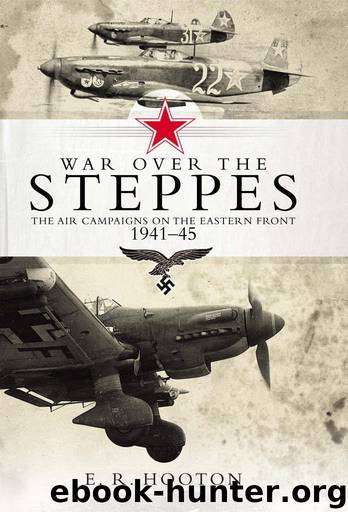War over the Steppes: The air campaigns on the Eastern Front 1941–45 by Hooton E. R

Author:Hooton, E. R. [Hooton, E. R.]
Language: eng
Format: mobi
ISBN: 9781472815644
Publisher: Bloomsbury Publishing
Published: 2016-10-19T22:00:00+00:00
CHAPTER 4
THE RUSSIANS ADVANCE
March 1943 to April 1944
The winter campaign concluded with the recapture of Kharkov on 16 February 1943, yet each step forward consumed supplies that were difficult to replenish. The Red Army offensives in late 1942 had torn a great gap in the German lines south of Voronezh, and from 29 January Krasovskii’s 17th VA weakly supported Skachok (Gallop) to isolate German forces east of the Donets by hitting troop concentrations, rail junctions and airfields.
Meanwhile, Richthofen ended his subordinates’ private wars on 5 February and instructed them to support Manstein’s Heeresgruppe Don, renamed Süd on 13 February; but two days later the Russians were approaching Manstein’s headquarters at Zaporozhe. Stavka was worried because the spearhead, General-leitenant Markian Popov’s Mobile Group, was running on fumes, yet Stalin would not rein in the Red Army. Manstein’s intelligence organisation and Luftwaffe comint discovered that ‘Gallop’ had slowed to a walk because Soviet troops were exhausted, and he decided to envelop Popov with a counter-offensive. Richthofen kept most of his forces in the Rostov area until 10 February, and was then involved in three days of conferences with Göring, Jeschonnek, Martini, Milch and Zeitzler, before flying to Zaporozhe for three more days of conferences, with Manstein planning this riposte. His aircraft began regrouping to support Manstein from 10 February, but they still had to shield an overstretched 400-kilometre-long line.
Richthofen was enthusiastic about supporting the counter-offensive and rushed to reorganise and rationalise his forces, sending the eight weakest Gruppen to rest and re-equip. Their departure not only allowed the remaining units to be strengthened but also reduced both the strain on the infrastructure and airfield congestion. Serviceability improved to more than 50 per cent because the Luftwaffe was returning to the excellent bases built the previous year near major supply depots, which accelerated re-equipment of Stuka- and Schlachtgruppen.
With 928 aircraft Richthofen retained control of the Kampfgruppen, but moved Korten’s Fliegerkorps I to Poltava to support Manstein’s left. Fiebig’s Fliegerkorps VIII was transferred to the Crimea, while Pflugbeil’s Fliegerkorps IV was in the centre at Dnepropetrovsk as his subordinate, Mahncke’s Fliegerdivision Donetz, covered Manstein’s right from Stalino, together with Gefechtsverband Hozzel – the Stuka force concentrated under StG 2 Kommodore Oberleutnant Paul Hozzel.
On 19 February, 4 Panzer Armee and Korten began the counter-stroke northwards towards Kharkov, while Pflugbeil used Mahncke as his spearhead to help 1 Panzer Armee isolate and crush Popov. Richthofen flew 1,145 sorties on 21 February and 1,486 the following day, with one Stukagruppe of 23 serviceable aircraft tallying 130 sorties. Korten and Pflugbeil concentrated upon Tactical Level support and were encouraged to operate across command boundaries, the daily average sortie rate reaching 1,000 as Hozzel supported the spearheads. Richthofen was also advised on Schlachtflieger by Weiss, who led Versuchskommando für Panzerbekämpfung (popularly known as Panzerjägerkommando or Anti-tank Command Weiss) with cannon-equipped Ju 87Gs and Hs 129Bs, which had greater success against armour than Stuka bombs.
The offensive drove into the left of Voronezh Front, which was supported by Smirnov’s 2nd VA
Download
This site does not store any files on its server. We only index and link to content provided by other sites. Please contact the content providers to delete copyright contents if any and email us, we'll remove relevant links or contents immediately.
| Africa | Americas |
| Arctic & Antarctica | Asia |
| Australia & Oceania | Europe |
| Middle East | Russia |
| United States | World |
| Ancient Civilizations | Military |
| Historical Study & Educational Resources |
The Radium Girls by Kate Moore(11634)
100 Deadly Skills by Clint Emerson(4697)
The Templars by Dan Jones(4561)
Rise and Kill First by Ronen Bergman(4549)
The Doomsday Machine by Daniel Ellsberg(4250)
The Rape of Nanking by Iris Chang(4024)
Killing England by Bill O'Reilly(3900)
Hitler in Los Angeles by Steven J. Ross(3803)
Stalin by Stephen Kotkin(3731)
12 Strong by Doug Stanton(3420)
Hitler's Monsters by Eric Kurlander(3170)
Blood and Sand by Alex Von Tunzelmann(3060)
Darkest Hour by Anthony McCarten(3019)
The Code Book by Simon Singh(2866)
The Art of War Visualized by Jessica Hagy(2845)
Hitler's Flying Saucers: A Guide to German Flying Discs of the Second World War by Stevens Henry(2626)
Babylon's Ark by Lawrence Anthony(2435)
The Second World Wars by Victor Davis Hanson(2423)
Tobruk by Peter Fitzsimons(2380)
